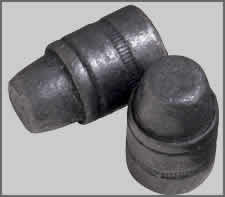- 01: Introduction
- 02: History
- 03: Propellants, Firearms, and Ammunition Development
- 04: Modern Firearms Manufacture
- 05: Small Arms Ammunition
- 06: Evidence Handling Procedures
- 07: Equipment and Instrumentation
- 08: Examination of Firearms
- 09: Cartridge and Shotshell Examination
- 10: Characterization and Evaluation of Fired Projectiles
- 11: Bullet Comparison and Identification
- 12: Gunshot Residue and Distance Determination
- 13: Toolmark Identification
- 14: Communicating Results
- Resources


Swaging
Home > Small Arms Ammunition > Projectiles > Swaging
Swaging requires a punch and die set mounted in a press, providing a mechanical advantage. The die cavity is shaped to match the desired profile of the bullet. The lead feeding into the swage die is normally a rough cylinder or slug that is somewhat smaller than the finished diameter of the bullet. Excess lead bleeds off as sprue.
The slug is cut from a long wire of lead that has been extruded under great pressure. A large billet of lead (usually cast) is placed in a massive hydraulic press and forced through a small hole in a die to form lead wire.

Swaged bullets
A post-swaging operation may add cannelures (or grooves) to hold extra lubricant and/or to provide a recess for securing the bullet in the cartridge case by crimping.
After the cannelure operation, bullets are sent to the lubrication area, where synthetic lubricants are applied. In some bullets, the lubricant is applied only in the cannelure, requiring special equipment and slowing the production rate. Most mass-produced bullets are dipped, covering the entire surface with lubricant.




